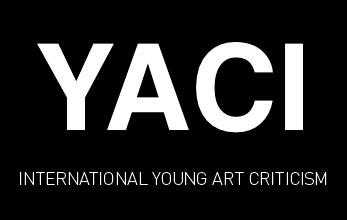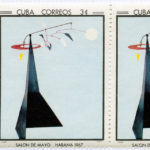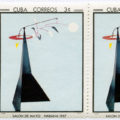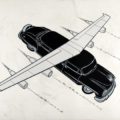Por un arte gusano y de solar
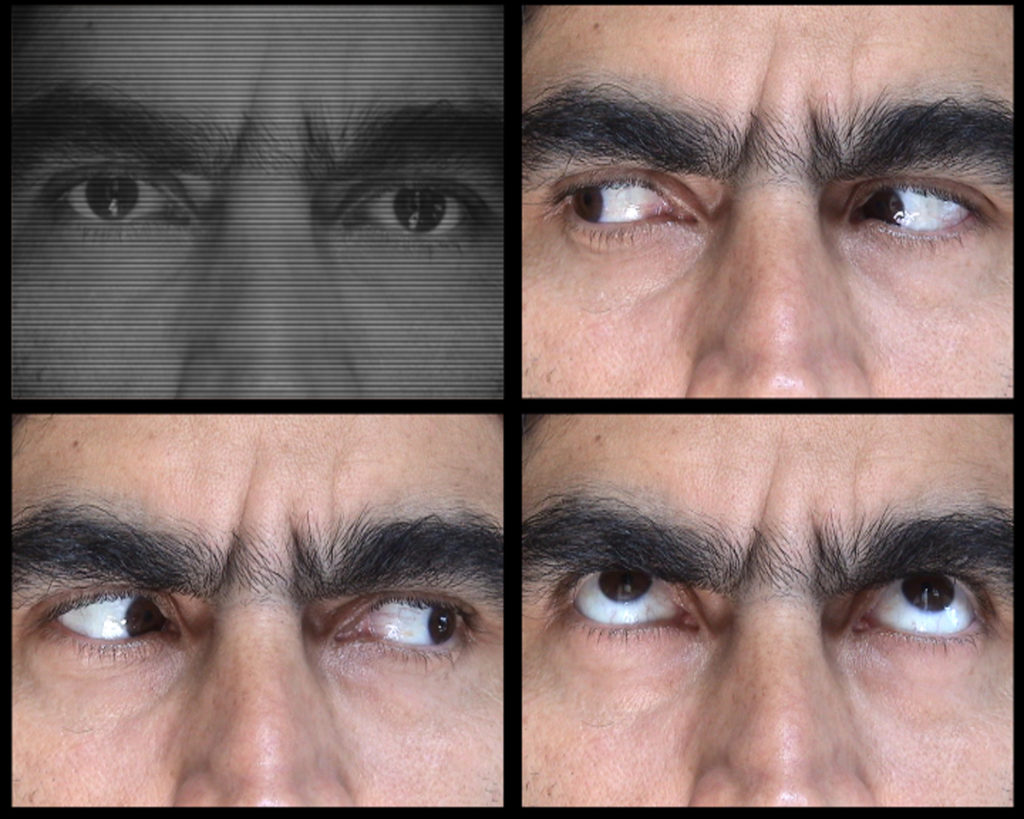
Long live the rag sir / And the table without a tablecloth / Long live the one who smells like an alley / A swear word and a workshop.
SILVIO RODRIGUEZ
by: Raymar Aguado Hernández
The vain villager believes that the whole world is his village¹, just as the enlightened silhouette believes that the essential only pigments his class. Dispute between blasphemy and whisper that encysters the narrative of enjoyment, as much as it subtracts the synergy in the transcendentality of expression. Zigzagging between shades of anger, while ignoring the cultural opposition, the irreverence of postulates, the antagonistic or the bastard. It shatters harmony in assimilation. So much denies the environment in which the processes flourish.
To transit outside a historical context is a model of impossibility that handles histrionics in a macabre way. Today cannot be denied, nor the totality of elements that compose it. There is a factual reality and another constructed one, but in this era of so much access to life, whoever pretends to create from the gross principle of exclusivity and weighting to a unique system of thought, shows only the face that promises to tear this century away from itself.
In the same way, to be submerged in the posture of the stale intellectual, who rejects any work that flees from the “profound” and “enlightened” archetype and, in a very ill-advised way, considers those that enter into that dogma as the pinnacle of creation, is nothing more than a pose highly constructed by an elite of enthusiastic negationists of a historical and popular knowledge. This form of exclusion does not belong to intellectuals, it belongs to classists.
Art transcends all snobbish or dilettante molds that, after all, are only symptoms of consumerism. Artistic processes -more now than ever- manage to be legitimate and, in a romantic way, conceptually art, only when they respond to the paradigmatic, esthetic and historical demands of the times.
Outside this contextual work, they are only fertilizer for marketing frameworks that subvert and intrumentalize the creative knowledge and freedoms of a given artistic imaginary. Even more so when, from hostility, a broad academic sector subverts and moralizes determinants in the cultural and artistic processes of the subaltern classes. The so-called “high culture” is a sinus body that causes us arrhythmias. To remove it, unlearn it and reconceptualize it is a health determinant for the future.
The Argentine researcher Adolfo Colombres pointed out that “the enlightened subculture ultimately contributes little to the history of colonized cultures. Its deep intention is to distinguish, not to communicate; it identifies a minority group that clings to an “exquisite” model to justify its power, turning it into an exclusive code, inaccessible to the majorities, since odi profanum vulgus is its golden rule, as well as the belief that the best cultural goods should be reserved. The dependent bourgeoisie thus changes the keys of art to turn it into an ideology of domination, and it is this negative, reactionary resemantization that turns spiritual values valid in their original context into subculture”².
This “enlightened culture” in its presentation of hermetic and excluding knowledge, invisibilizes or stigmatizes the practices that break with its tableau of uniformity. Its main motto is to impose, within a determined imaginary, the label of vulgar or immoral to any aesthetic provocation that dissents from its schematic order. In this way, they obtain the exclusivity claimed by their proposal, while creating a symbolic segmentation of what can be a cultural product and what cannot.
In the Cuban case, the Creole enlightenment of the 19th century promoted hegemonic knowledge as the summit of a national cultural process, a practice that continued during the Republic. In this way, the classist, racist and segregationist pattern was repeated, violating the identity of a majority group that had no choice but to succumb to the dictates of that elite.
At the same time, the high bourgeoisie appropriated and instrumentalized -given its political-economic weakness- the culture most deeply rooted in the popular sectors, to the point of institutionalizing it for populist purposes. After 1959 and the “Words to the intellectuals” pronounced by Fidel Castro, the island suffered the abrupt influence of Eastern European cultural capital, while opportunities for debates on internal creative dynamics were closed.
Everything was centralized while people were deprived of the power to make critical and frontal judgments. At the same time, the subalternity of certain sectors was denied and, consequently, they were marginalized and condemned to disengage from their culture, so much so that religious practices such as Yoruba and Abakuá were outlawed.
The Cuban evolution has evoked a series of processes that subdivide the integrality of the majority, reducing the range of discursive action to diégesis limited by the political and historical closures that have set limits to the national culture. The latter, hackneyed and symbolically turned into a political souvenir, demands a semiotic restructuring of the formulas in which it is conceived, as long as its identity traits -those we are trying to judge- have the fullness and the recognition they demand.
A peculiar case is that of the “reparto” and the “racamorfa”, core expressions of a popular ethos that carries in itself the essence of practices and knowledge extended throughout the Cuban territory and that represent a very faithful definition of Cubanness. These genres are pointed out as indecent, vulgar, marginal and, in the most recalcitrant cases, as an aberration.
These expressions are deprived of the condition of active cultural object within their contextual dynamics. Their staunchest enemies, coincidentally, belong to an enlightened and conservative elite that schematizes the cultural reality in proportion to their designs, so much so that during the second decade of this century artists of these genres were not recognized as creators by the Cuban institutionality. They have even been subjected to campaigns aimed at discrediting their works and trying to point out their negative social impact.
The institutionality wields criteria such as that they incite to violence, that they only talk about sex in their songs or that it is trashy music. It is totally inconceivable how, in a political process that began under the maxim of empowerment of the oppressed sectors, the identity culture of these social groups is delegitimized with clacist and discriminatory arguments.
Therefore, understanding cultural dynamics from the positivist rhetoric of overcoming for integration is a big mistake. It is no less true that people need to develop a cognitive imaginary focused on their context and reality. But first they need security and the minimum guaranteed living conditions.
The integral culture of the individual goes hand in hand with the contextual development that his closest environment has, that is why Martí pointed out in Maestros Ambulantes: “To be good is the only way to be happy / To be cultured is the only way to be free / But, in the common of human nature, one needs to be prosperous to be good”³.
The individual responds unequivocally to his or her social reality and is conditioned by his or her life model. The cultural expressions of a given group, in this case the reparteros, go hand in hand with the environment in which they develop. These people are, in any case, a reflection of their reality, which is conditioned by impoverishment, racialization and marginalization.
And, since these realities are a by-product of the historical and political scheme of the country, they have a determining space in its identity culture. The cast is as Cuban as the punto guajiro, the son or the chachachá. Likewise, Chocolate MC is as important for the Cuban cultural framework as Juan Formell, Silvio Rodríguez or Ernesto Lecuona.
On the other hand, the ideological divisionism in the flora and fauna of Cuban culture has been a determining factor in the cultural policies of the last sixty years. The aforementioned “Palabras a los intelectuales” (Words to the intellectuals) meant in 1961 the beginning of a process of short rein in the field of creation in Cuba.
The policy established by Fidel Castro on art, esthetic patterns, creative commitment and national identity twisted the path that artists set out to follow after January 1959. Coincidentally, that same year would see the light of day an essential essay to understand the proceedings of the national culture from a historical approach. I am talking about How National Culture Emerged, by Walterio Carbonell, a text that lays bare the whole process of development of the Cuban cultural identity.
In this book, the author exposes a whole series of events that show the importance of popular culture and the subaltern sectors in the formation of national identity and how the Revolution made it possible to take all that explosion to a level of absolute integration. Unfortunately, the foundations were already laid for what was to result in an endless number of censorship, labor expulsions, creative impediments, exiles; in what we can frame as the greatest attack against our culture.
The denominator of greater treatment in the processes of cultural exclusion in Cuba in recent years is, undoubtedly, the lines of political thought. The educational paradigms imposed from the programmatic order of the school system of all teachings present a strictly uniform path that advocates the construction of ideological archetypes. Illegalizing dissent was the last step with the new Penal Code, but for decades it was chosen to moralize it, marginalize it and place it as one of the main faults within the ethical reality of the country. Victims of this were, and are, countless creators.
As the spectrum of creative expression was limited, the treatment of the political issue took on a tremendous level of subjectivity. After the Pavonato, the Quinquenio Gris and the Mariel exodus, came the fever of the eighties and its new gadgets. Creation took on new nuances on the island and the political variable was no stranger to the situation.
At that time, fundamental exponents of our art such as Eduardo Ponjuán, René Francisco Rodríguez and Lázaro Saavedra were making their first steps. They, along with many others, would complete their cycle of discursive solidification by the nineties and the beginning of the new century. The tone that was offered to the contextual work from art in those years, to give examples of the artists mentioned, is evident in works such as Detector de ideologías (1989-2009) and Síndrome de la sospecha (2004), by Lázaro Saavedra, Utopía (1991) by Eduardo Ponjuán and René Francisco Rodríguez, Sur (2007) by Eduardo Ponjuán and Homenaje a los 60’s (2009), also by René Francisco.
These works explore pressing issues within the national critical spectrum, as they analyze them with a surgical eye, complementing the aesthetics of a crucial cycle for the contemporaneity of Cuban culture.
At present, the theme of creation with a moderately political tone creates dissonances in the scheme of domination of the official caste of the island, to the point of taking extreme and inhumane measures against anyone who appears tangential to the proposal of the State. An example of this is the imprisonment of Luis Manuel Otero Alcantara and Maykel Castillo (Osorbo), the deportation of Hamlet Lavastida, the repeated censorship of Emilio Frias, director of the group El Niño y la Verdad, as well as the cancellation on three occasions of the literary panel La Peor Generación by the organs of State Security.
One of the main arguments presented by the political power and its censors at present when it comes to canceling a work is the power of subversion they grant it. It is no less true that every artistic pretension is a political insinuation, especially when it germinates in a context determined by confrontation and verticality. Besides, it is well known that the conclusion of the work is determined by the receiver, who, in his context, resignifies it according to his situation.
I emphasize that censorship politicizes encounters; closed-mindedness politicizes perspectives; disengagement and rejection politicize intentions. Art will never be an element of strict politicization, although its objective is to relate an artistic imaginary, which unequivocally responds to a political context. Therefore, in the Cuba of today, it is the power from its triad Party/State/Government that imposes an orbit of political treatment to creation.
It is clear that the work of art, under any term, is to dissent. To dissent from the static, to dissent from tiresome morosity, to dissent from the archaic, to dissent from dissent itself. There is nothing more political than dissent. Art must be the point that opens the furrow and the critics who sustain it. Gerardo Mosquera pointed out in an interview that contemporary art serves as a banner to make critical art, thus finding the best method to be consistent with this century’s sarabande.
Thus, one of the worst burdens an artist can drag to the detriment of his work is the alienation -either out of pure opportunism or fear- of his contextual situation, as well as disbelieving and/or denying it. Requesting the safe conduct of convenience to life is a pothole in the mysterious cycle of the human essence.
For example, within the Cuban institutional framework there is a morbid polarization in the creative approaches of artists. Parameterization, the demand for militant commitments, as well as the limitations of thought, point to the chronological order that evidences the cracked and foul-smelling nature of that structure. Therefore, being cloistered in the comfort of living exempt from hostilities in those instances, although it does not make you guilty, it marks you as an accomplice of the hecatomb, especially at a time when Cuban totalitarianism has taken off all its masks and is exposed as a fulminating beast.
Criticism plays a fundamental role in these processes. Unfortunately, in Cuba this exercise has diminished in the success of certain currents of cultural journalism that create such arbitrary and ill-advised conditions.
Critic Andres Isaac Santana pointed out that “the confusion between art criticism and cultural journalism is regrettable, as well as that sad tendency to establish false and unfounded hierarchies. The critical will, that which is understood as an exercise of commitment that tests our position within the system, must overcome the tautological scarce and the grammar of complacency. The history of criticism is nothing but the story of impartiality and disagreement. Criticism is criticism always, in spite of everything”⁴.
There is no worse cancer for creative processes and their discursive and symbolic postulates than paternalism and condescension. The sweetening of the simple creation, or the mere fact of the concretion of a work, are nothing more than fallacies that structure and enhance the medianía in the discursive-aesthetic framework that is art.
The loss of rigor conditions a mercantilist and made-up outburst where the most ephemeral and inconsequential treaties pass for successes. Cuban criticism deserves an overwhelming response on the part of creation. It is a task of order to separate the concepts of entertainment and hobby from that of art. The latter is a philosophical aspect of human expression, where a myriad of historical-cultural knowledge that narrates identities is gathered. Not every aesthetic-discursive sketch that is attempted possesses the spirit that this one claims. The failure -simply and simply for being in itself an act of resistance and creation- is to be applauded as much as the concretion of solidity in a work. But one cannot stigmatize the unsuccessful pretensions as a success, since it is at the expense of instrumentalization and sophistry.
Criticisms that are often called “destructive” from different spheres are non-existent. Within the eagerness for renewal and growth, every point pointed out, even if it burns, is a support for improvement, especially when the criticism demands consonance with the historical reality that the artist and his work live. These are times when the manofacture and formalisms diminish before the discursive compendium of a creation, so much so that while the technical point is emphasized, the cultural impact of the masses that a work may have is ignored. Therefore, the efficient objective of contemporary criticism must be committed to history as a whole, from the point of view of ardor. Neutrality in the art of judgment is an entelechy; criticism is fire, or, simply, it is not.
The task of an exegete, as critics are, transcends any banality based on the immaturity presented by the creators, or those who plant themselves intransigent defenders, to assume the critical work in the maturation of their creative work. Rigor -no matter how rough it may be- is what solidifies the critic’s ethics. Only rigor is capable of sustaining the standards demanded by art and its time.
Criticism is the act of undressing the work and its being with a fervent exercise of criteria, without falling into descriptive trachemy or trifles that result in the obsolescence of postulates and concepts. Criticism is not (only) journalism, criticism is judgment and sentence: exegesis. The critic is an aesthete, not (only) a columnist of a press bulletin, he owes as much to his work as to the height of his time.
So, what kind of criticism does contemporary Cuban art need? In my opinion, a decolonial, anti-mercantilist, decolonized, committed to popular culture in all its extension, all-encompassing, solarian, and above all, dissident one. May the future do justice. The time to compost has just begun, much remains to be done.
———–
1- Phrase with which José Martí begins his famous speech Our America. José Martí, Obras Escogidas en tres tomos, Second Volume, Centro de Estudios Martianos, Editorial Ciencias Sociales, 2007, p. 497.
2- Adolfo Colombres, Teoría de la cultura y el arte popular, Ediciones ICAIC, 2014, “Arte culto y arte popular: entre el encerramiento y el universalismo”, p. 90.
3- José Martí, Obras Escogidas en tres tomos, Primer Tomo, Centro de Estudios Martianos, Editorial Ciencias Sociales, 2007, “Maestros Ambulantes”, p. 457.
4- Andrés Isaac Santana, ¿Ejercicio crítico u opinión de barricada?, Hypermedia Magazine, January 28, 2020.
